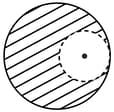EASY
Earn 100
Consider a planet moving in an elliptical orbit around the Sun. The work done on the planet by the gravitational force of the Sun:
(a)
is zero in any small part of the orbit
(b)
is zero in some parts of the orbit
(c)
is zero in complete revolution
(d)
is zero in no part of the motion
50% studentsanswered this correctly
Important Questions on Gravitation
MEDIUM
MEDIUM
MEDIUM
MEDIUM
MEDIUM
MEDIUM
MEDIUM
MEDIUM
EASY
EASY
MEDIUM
MEDIUM
MEDIUM
(Ignore the rotation and revolution of the Earth and the presence of any other planet)
EASY
MEDIUM
HARD
MEDIUM
EASY
EASY
HARD
From a solid sphere of mass and radius a spherical portion of radius is removed as shown in the figure. Taking gravitational potential at the potential at the centre of the cavity thus formed is (gravitational constant)


